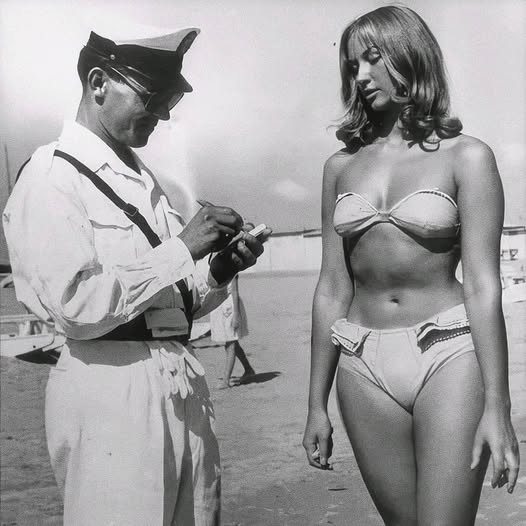At first glance, it may seem like just an ordinary photo of a woman enjoying a day at the beach, but a closer look reveals a garment that has sparked global controversy, cultural debates, and even legal action throughout history—the bikini. What looks simple and innocent has actually been at the center of a powerful cultural battle between modesty and self-expression.

This tiny piece of fabric has been both condemned and celebrated, banned by governments and embraced by women who chose to challenge outdated norms. While popes called it sinful and conservative leaders labeled it immoral, countless women around the world wore it proudly, using the bikini not just as beachwear, but as a declaration of freedom. Back in the early 1900s, swimsuits were designed less for sunbathing and more for modesty. Women wore woolen, full-body outfits that covered them from neck to knee. These suits were bulky, heavy, and served as a visual shield to prevent scandal.
Strict dress codes governed public beaches across the United States. In places like Clarendon Beach in Chicago, officials had tailors standing by to patch up suits that revealed too much. Coney Island banned bathing socks if they showed a woman’s dimpled knees. In Washington, D.C., beach police patrolled with measuring tapes to ensure swimsuits didn’t violate decency laws. Showing any skin beyond the regulated amount could result in public shaming—or even arrest. However, by 1907, change was brewing when Australian swimmer Annette Kellerman challenged convention by wearing a sleek one-piece suit that showed her neck, arms, and legs. Dubbed “the Australian Mermaid,” Kellerman’s bold fashion choice made headlines and allegedly led to her arrest, though records are unclear.
Regardless, her statement sparked interest in more practical swimwear, and her “Annette Kellermans” line of suits became a hit. The 1920s ushered in more rebellion. The rise of the flapper movement began to influence how women dressed, including at the beach. A group in California, known as the “skirts be hanged girls,” pushed for tighter, more mobile swimsuits. Though still modest by modern standards, swimwear was slowly shedding its conservative skin. But the real revolution didn’t arrive until 1946, when French engineer Louis Réard introduced the bikini—a daring two-piece that exposed the navel. Just days earlier, the U.S. had conducted nuclear testing at Bikini Atoll, a coincidence that only amplified the swimsuit’s “explosive” cultural impact. The reaction was swift and severe. Many U.S. beaches banned bikinis. France outlawed them in 1949. Germany didn’t allow them in public pools until the 1970s. Countries like Spain, Italy, Belgium, and Portugal issued nationwide bans. The Catholic Church labeled it sinful.
In 1952, an Australian model was even asked to leave a beach for wearing one. An iconic photo from the era shows an Italian officer appearing to fine a woman for indecency. While the details remain fuzzy, it reflected a broader social anxiety around changing norms. In the 1960s, as the cultural landscape shifted, bikinis gained more acceptance. Feminism, evolving fashion trends, and changes in film helped open the door. Yet restrictions lingered. Hollywood’s Hays Code banned navel exposure, and watchdog groups fought to keep bikinis off-screen. Still, stars like Marilyn Monroe, Brigitte Bardot, and Ursula Andress made headlines. Bardot’s film The Girl in the Bikini turned the garment into a symbol of effortless sensuality. Andress’s appearance in Dr. No—emerging from the ocean in a white bikini with a knife at her hip—cemented the bikini’s status as both sexy and strong. By the 1970s, the bikini was mainstream. Swimsuits became smaller and bolder, and men’s swimwear followed suit. The modesty of the early 20th century had vanished, replaced by an emphasis on self-expression. Today, swimwear represents individuality. Whether someone chooses a modest one-piece or a revealing thong bikini, the focus is on what makes them feel empowered. It’s no longer about meeting society’s expectations, but about celebrating comfort, confidence, and choice. That tiny garment once labeled scandalous is now a powerful symbol of progress. It’s more than fabric—it’s a reflection of how far we’ve come in honoring the right to be seen, accepted, and celebrated for exactly who we are.





